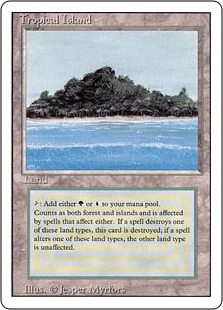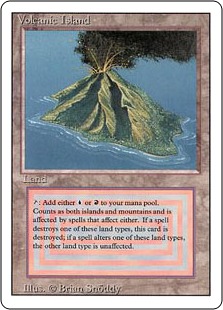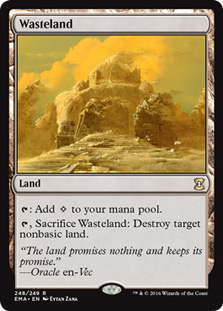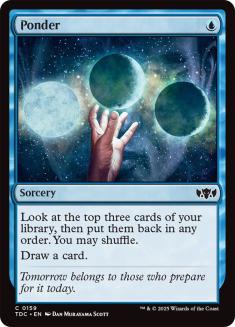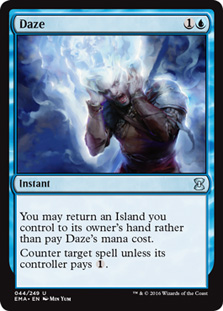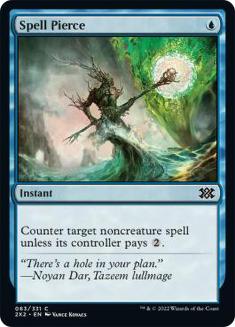So you want to be the bad guy, huh?
Everyone’s aiming at this deck now, you know. People may have jumped on the Lingering Souls Express for a week, but everyone has figured out by now that this really is the best deck in the format. But that doesn’t matter. You want to play RUG Delver, you want to crush souls, and you want to know exactly how to do it. In that case, let’s start with one of the least-understood parts of the deck: how to mulligan with it.
Mulliganing
The first thing you need to understand about RUG Delver is that it has no way of gaining card advantage, so you need a very good reason to mulligan. I probably keep 80% of my hands with RUG Delver, with the following things being compelling reasons to go to six cards:
- I don’t have a land that produces blue mana.
- I have exactly one land, no Ponder, and no one-drop.
- I have five or more lands with no one-drop and no cantrip.
Really, that’s about it. If you listen to Paulo and believe that this is an aggro deck, you may be tempted to mulligan to a one-drop. Don’t. You’ll lose more games in the long run by doing that than by keeping a lot of the looser hands in my range.
But wait. Don’t aggro decks need a one-drop? Shouldn’t you mulligan to that one drop instead of keeping something like this?
A lot of people would argue that you’re treading water here. You aren’t casting a one-drop on turn 1, so all of your interaction is going to be buying time at card and mana parity. Here’s the big secret about RUG Delver that no one seems to remember, though:
You topdeck action better than your opponents in every single matchup. Remember, you only play eighteen or nineteen lands.
Sure, you can go to five cards and play a Delver of Secrets on turn 1, but you’re going to lose to a Swords to Plowshares that plays around Daze and Stifle and Spell Pierce basically every time you do that. If you keep the above seven-card hand instead, you can trade cards with your opponent, eventually cast a creature, draw another creature, draw the rest of the action in your deck, and kill them eventually. You aren’t really in a huge rush to kill people in a bunch of your matchups, given how versatile your cards are and how consistently you can set up one-for-one exchanges.
People who don’t play the deck that much talk about how the deck “needs” a one-drop just like Mono-Red “needs” a Goblin Guide. Sorry, neither is true. Sure, it’s nice to have your best opener, but you can win games where you don’t have it. Mono Red doesn’t mulligan to Goblin Guide. You shouldn’t make a habit of mulliganing to Delver of Secrets and Nimble Mongoose.
Deckbuilding Decisions and Why Stifle is Bad
Not all RUG Delver lists look the same. There are a lot of similarities between various lists, but certain card slots are off by a few numbers from list to list. There is one very important difference between the list I advocate and some lists that people choose to play.
I don’t play Stifle. I don’t make a secret of it. I think the card is cuts. I say that having played it in a deck where the objective of the deck was to cast Stifle as much as possible. Don’t believe me? Take a look for yourself:
Creatures (9)
Planeswalkers (2)
Lands (24)
Spells (25)

This is a deck that genuinely wanted to flashback Stifle. It was a Stifle theme deck, if you will. It functioned on the premise that Stifle is a versatile card that’s good in a lot of different matchups in a different way for each matchup. When it was bad against a deck, I would have built-in functionality with Phyrexian Dreadnought.
Guess what? I used Stifle to do a bunch of stuff against a bunch of different decks and it still wasn’t that great. Sure, it could do something whenever I drew it, but whether that something was strategically relevant or even worth a card is another test entirely (and not one that it passed with any regularity).
Stifle was good for me for the same reason that Standstill was good in Orlando a year ago: people are very bad at playing against it. For those of you who want to beat Stifle on a regular basis, here are three easy steps that you can follow:
- Before you turn in your decklist, cut a spell for a basic land.
- When your opponent cracks a fetchland for a Volcanic Island and passes the turn, play and activate your fetchland if you have a play on turn 1. If you don’t, activate your fetchland in their upkeep.
- Either they have it or they don’t. They aren’t going to stop having it just because you wait. They are more likely to draw Stifle as the game goes on. You can either let this be a good thing for them or a good thing for you.
The real reason that Stifle is unplayably bad is that it’s probably the worst topdeck in Legacy. Well, no—the real reason that Stifle is unplayably bad is that it’s probably the worst card in Legacy on the draw. Well, wait—the real reason that Stifle is unplayably bad is that it doesn’t stop anything you care about. Having it on turn 1 and hitting their fetchland is the dream, but what if they just crack it in your upkeep? What if they just play their other lands first, play their spells, and then play and crack their fetchlands when you have mana tapped for Tarmogoyf or Ponder into Delver?
What if Stifle is making you play worse by creating false dilemmas between holding mana up for Stifle and casting a spell that will benefit you (Ponder, Brainstorm, or a creature)? What if Stifle was a card that actually stopped cards you actually care about? Wouldn’t that be a little better?
Let’s make a list of cards that beat us the most:
- Liliana of the Veil
- Batterskull
- Engineered Explosives
- Lingering Souls
- Jace, the Mind Sculptor
- Swords to Plowshares
- Perish
- Reanimate
- Show and Tell
- Ad Nauseam
- Fireblast
- Green Sun’s Zenith
- Inquisition of Kozilek
Stifle may be able to interact with the first three cards to a reasonable degree, but it does next to nothing about the next ten. If you need to peel a card to buy you another combat step with your Nimble Mongoose or Delver of Secrets, Stifle is almost never it.
“But Drew!” you might say. “I like the free game wins that Stifle gives me! I enjoy punishing my opponents’ poor keeps! Stifle does that and that’s an appealing prospect to me.”
I understand your position, straw man. But have you considered the possibility of an opponent keeping a reasonable hand that doesn’t lose to Stifle, having a game play out normally, and getting into a spot where you can just win your legitimately-played game of Magic by Spell Piercing their key spell or lose it because you have a do-nothing Stifle in hand? I know that going to a Magic tournament and trying really hard to not play Magic is attractive, but not everyone is going to get mana screwed, not everyone is going to wait until you have three Stifles and three mana up before they try to crack their three fetchlands, and not everyone is going to draw their fetchlands when you draw your Stifles. What happens then?
Because I’ll tell you right now, I’m not a fan of Stifling a Stoneforge Mystic. I’m not a fan of Stifling the living weapon trigger on Batterskull. I’m not a fan of Stifling Jace’s Brainstorm ability. I would rather Bolt or Chain their Stoneforge and then Spell Pierce the other two. If the game goes long, you aren’t going to have a lot of choices in terms of what you’re Stifling—the first moving target is probably going to be too appealing to pass up, even if it’s the fetchland that gets their sixth land.
Spell Pierce, on the other hand, is amazing. Think about Legacy on its most basic terms for a second. What defines Legacy? Is it defined by powerful activated abilities, powerful creatures, or powerful spells? In my experience of the format, Legacy is all about the spells. If that’s true, then it stands to reason that Spell Pierce would be a really good card.
I promise this is not a question of “play style” or anything so vague and meaningless. Please don’t play Stifle just because you saw a winning list play it “so it must be good.” I put in the hours, I played the matchups, and I can promise you that Spell Pierce is a categorically better card than Stifle in today’s Legacy format. If you believe that you’ll win all of your die rolls, feel free to play Stifle and pray that they have a fetchland on turn 1 and choose to use it at a very convenient time for you.
I’ll keep playing Spell Pierce, though. Spell Pierce interacts with more of the format, granting its wielder a broader range of potential interactions. If you believe that you can outplay your opponents—and you clearly do since you want to play this instead of a far more mindless deck—then why would you choose a higher-variance, lower-skill card? Play the card that gives you more options, better options, and lets you win games that Stifle could never win for you. Spell Pierce for President in 2012!
Forked Bolt vs. Chain Lightning*
This decision is far closer than Stifle versus Spell Pierce. These cards do similar things, but one is better as a nug and one is better as a removal spell. In a metagame where you really want good tools against Maverick, though, it’s very likely that Forked Bolt is better as it has the potential to Twinstrike their Mother of Runes / Noble Hierarch / Dryad Arbor or to “just” work as a mini- Searing Blaze on any one of those creatures. It can hit the front end of a Lingering Souls, which makes the difference between them being able to triple-block a Nimble Mongoose and relegating their Spirits to chump-blocking duty.
On the other hand, making the decision to play Chain Lightning positions you as a more racing-oriented, “count-to-twenty” deck, as Matthias Hunt characterized RUG Delver this past weekend. Matthias was onto something very real, though. RUG wants to get to twenty and often gets to exactly twenty with Chain Lightning. There’s a reason why Shock is a footnote in the world of burn spells and Lightning Bolt is the best: three is a lot more than two. If you know that you’re going to be racing your opponent, Chain Lightning is going to be a lot better than Forked Bolt. You can play the Maverick matchup as either a super-aggressive deck that plans on killing them with a flipped Delver of Secrets or as a grindy deck where you focus on killing their early creatures rather than starting up a substantial clock, landing a few threats, and then countering their cards that stop you.
*As a sort of footnote, I don’t particularly like Dismember. I get it—you want to kill Tarmogoyf and Knight of the Reliquary. Do you want this in the mirror, though? Are you paying four life to kill their Tarmogoyf? What happens when your opponent just lights you up and you realize how essential those four life points were? Against Stoneforge, Dismember is easily worse than either sorcery. Against Maverick, I would rather fight their life total than a single Knight of the Reliquary. They’re going to have more where that one came from. It’s also plausible that you draw Dismember when their Knight is out of Dismember range, making it embarrassingly bad. Overall, I’d rather play Chain Lightning or Forked Bolt.
The Other Counterspells (and Why Three is a Good Number)
A valuable part of playing RUG Delver is being able to pass the turn with two mana up and forcing your opponent to figure out which of Daze, Force of Will, Spell Pierce, and Spell Snare they want to try to beat. Fitting all of those instants into your deck, though, is a tall order. The way that I went about building my list was to figure out which instants are the best, play four of those, and then play three of each instant that I wanted to draw exactly one of in each game. I believe it was Michael Jacob who said, “A four-of is a card you’re never allowed to complain about drawing three of.” I leaned on this principle to guide my decisions for building this deck. Here’s the list of counters, for reference:
Spell Pierce — My pick for the best counterspell in Legacy right now, as it’s almost always going to gain you tempo advantage and hits a spell that they probably need to stabilize against you. I’m rarely sad to draw three in a game, so I’m happy playing the full set.
Daze — Given how much people have raised their curves recently (Lingering Souls, anybody?) and given the rise of Snapcaster Mage, Daze has value going much later than is typical. With that said, I would be frustrated to draw three of this in a game, especially since Spell Pierce is already a four-of and they do similar things.
Force of Will — The sacred cow whose throat was far too ready to get cut open. If you’ve ever played RUG Delver and drawn three Force of Wills, you’ll know exactly why three is better than four. In all honesty, it might be right to play two Forces if you have four Spell Pierces, as Spell Pierce is very often just a better Force of Will.
Spell Snare — Does exactly what the card says but isn’t so good that you want to draw three a game. They’re fairly underwhelming against Maverick, narrow but important in the mirror, and consistently decent against Esper, but it’s never a card that you are really thrilled to cast. It does a job, it does it well, and you generally want to draw one or two a game.
This gives you a solid wall of thirteen counters that an opponent has to work through over the course of a game, letting you play a consistent aggro-control game and giving you a lot of options with your cantrips in the midgame. Speaking of cantrips…
Thought Scour vs. Predict vs. Sensei’s Divining Top
Thought Scour does a lot for this deck. It turbo-charges threshold for Nimble Mongoose, it “shuffles away” your bad cards from Ponders and Brainstorms, and it flips Delver of Secrets. If you see an undesirable card with Delver of Secrets, you can Scour it away before drawing it. If your opponent hits their out with Delver of Secrets, you can Scour it away and only have to deal with their 3/2 flier. If you Submerge a Knight of the Reliquary or Tarmogoyf, you can Scour it away (and yes, that happened at the SCG Invitational in Baltimore twice). If people try to get cutesy with Personal Tutor for Temporal Manipulation, you can Scour that away too.
I mostly view Thought Scour as a way to turn on threshold faster. Nimble Mongoose is a great threat, but it’s pretty dangerous to send it in against a blue deck that has two mana up, as any Esper deck would love to trade an Ambush Viper for a Nimble Mongoose. Thought Scour lets you send Mongoose in with as few as four cards in your graveyard and then kill their blocker and draw a card for the low, low price of one blue mana. It can also be used as a Hail Mary when you need to grow your Tarmogoyf by putting a new card type in the graveyard.
I like Thought Scour more than Predict or Sensei’s Divining Top because it does more that you care about, requires no setup, is a blue instant for Delver of Secrets, is more efficient than either of the alternatives, and has minor utility against various other parts of Legacy’s vast card pool.
Also, for those of you still playing Sensei’s Divining Top, stop. It’s not good. Counterbalance is unnecessary and bad. Play Spell Pierce and a real sideboard that solves actual problems that you actually have. You don’t need to embarrass combo pilots even more than you already do.
Before we touch on the sideboard, I want to make a few points about the creature base for the deck.
Tarmogoyf vs. Green Sun’s Zenith + Scavenging Ooze + 1 Tarmogoyf
Are you f&$!#@g kidding me? Do you know what Tarmogoyf does? Have you read the card? Maybe seen it in play a few times? And you want to cast a two-mana Nimble Mongoose instead? Listen, I like Nimble Mongoose more than most and I still don’t let that get in the way of how undeniably good Tarmogoyf is, especially in this deck.
Let’s set aside the whole “playing one Tarmogoyf is not the right number” argument for a second and examine how Green Sun’s Zenith works with the rest of the deck. I will grant that there’s a matchup where Mongoose is awesome and Tarmogoyf is a Sacred Nectar + Raven’s Crime. I will grant you that Green Sun’s Zenith also flips Delver of Secrets where Tarmogoyf doesn’t. That said, there are other matchups (plural) where Mongoose is fine and Tarmogoyf is the most important card in the matchup. Like, you know, the mirror.
If you want to see what one Tarmogoyf versus four Tarmogoyfs looks like in the mirror, feel free to watch this.
You will also gain an appreciation for how good Spell Pierce is against a deck that relies on Green Sun’s Zenith to find its one Tarmogoyf. Mostly, though, game 1 is a showcase of how important Tarmogoyf is in the mirror. Getting Green Sun’s Zenith Spell Pierced is a huge deal, but it goes deeper than that: having four Tarmogoyfs to Ponder and Brainstorm into as the game goes long is a very real edge in the mirror. Furthermore, playing Green Sun’s Zenith encourages you to cut Spell Pierce, as you will want to tap out for your Zeniths. Since Spell Pierce is awesome and playing Stifle isn’t, the choice is clear.
Play four Tarmogoyf, ladies and gentlemen. You won’t regret it.
Nimble Mongoose
Nimble Mongoose is the real reason why RUG is favored against Stoneforge Mystic decks. Their choice to play a removal suite that doesn’t really touch Nimble Mongoose at all is very meaningful, since it gives you a legitimate threat going long. Whereas a “true” aggro deck would never want to go long, RUG Delver is actually fine in a super late game as it can just drop an untargetable 3/3 and go to town. Jace, the Mind Sculptor becomes less effective as an inevitability tool for a deck like Esper against RUG Delver with four Geese, since Jace can never bounce Mongoose and must rely on his minions to protect him.
In general, I like to play more conservatively with my 1/1 attacks (both Delver and Mongoose) into Snapcaster mana than most people. Trading a Goose with a Snapcaster against Esper Stoneblade is one of the worse things that can happen in that matchup, as your Geese represent a lot of value against their deck of 1/2s, 2/1s, and 1/1s. Making bad attacks is a great way to lose. Don’t make bad attacks.
No Snapcaster Mage
Every single time I drew a Snapcaster Mage in testing, it was a miserable feeling and I wanted to cycle it. I was elated to get to Brainstorm them away, and I sideboarded them out a lot. Eventually, I realized that the ubiquitous 2/1 isn’t something that this deck wants. If you want to get ahead on cards, play Stoneblade—that deck is filled with two-for-ones. If you want to walk a tightrope, have to play perfectly, but get ’em dead a bunch, play this deck. Snapcaster isn’t so good at getting them dead. He’s very good at getting ahead. Instead of getting ahead, just get ’em dead. It’s much better.
Sideboard Options
Counterbalance and Sensei’s Divining Top: For when you want to waste half of your sideboard to turn your 75% matchups into 98% matchups. No, seriously, that’s what they do.
Pyroblast: You only really want two cards against combo decks, since you want to cut two Forked Bolt or Chain Lightning for two anti-combo slots. Pyroblast is probably the best card for that job, since the combo decks that see play nowadays are all heavily blue; Show and Tell, High Tide, and Storm all have important blue cards that are worth Pyroblasting. It’s also a very good card against blue control decks, since their game plan in sideboarded games is to get to six mana and resolve Jace, the Mind Sculptor through a Spell Pierce. Being able to beat that plan is a good reason to play something like Pyroblast.
Hydroblast: If you’re very, very sure that you’re going to fight through Fireblasts and Goblin Guides, it’s worth packing a few. If you want these to try to next-next-next-next level the mirror, there are better ways.
Sulfur Elemental: I wrote a fair bit about this two weeks ago, but all due credit to Jarvis Yu. The card does what it says. If you’re having trouble with white x/1s, it’s time to get down with Sulfur Elemental.
Sulfuric Vortex: A lot of control decks just can’t beat this card. Seriously, how many ways does Esper have of beating this card? It shuts off their ability to stabilize the board pretty thoroughly, since their general game plan is to get counters on Umezawa’s Jitte or to attack with a Batterskull. They can race your Vortex with Lingering Souls Spirits, but Sulfur Elemental is good at stopping that. They can try to brick wall you with Batterskull and hit you for four a turn, but you can still get them with Insectile Aberration. It gets even worse for a planeswalker-based BUG Control deck: they might only have Pernicious Deed as an out to a resolved Vortex.
Ancient Grudge: Given how much more Esper taps out than U/W Stoneforge did, Ancient Grudge is probably pretty good again. Even if you have Sulfuric Vortex in play, Jitte has two abilities that don’t gain life and Batterskull is still a 4/4 vigilance creature. There are also other decks that play artifacts in the format, so it’s not as though you’re going to be disappointed if you pack a two-for-one Shatter in your sideboard.
Submerge: If you’re bringing this card in against someone, it’s very likely your best card against them. Given that you’re not favored against Maverick, I would play four. It’s also one of the few ways to make headway in the mirror, as you generally don’t have a good answer to Tarmogoyf. Believe me, I’ve tried:
…and eventually settled on the next card as a way to gain Tarmogoyf advantage in the mirror beyond just having Submerge + Thought Scour.
Scavenging Ooze: This is the deck’s hybrid Tormod’s Crypt and Tarmogoyf. It crushes the mirror, it’s a great way to lock Reanimator out, and it’s a solid tool against Dredge that also clocks them, letting you leave up your mana for your counters and activations. I was very happy with this at the SCG Invitational in Baltimore and would definitely play them again. It also makes Lingering Souls awkward by forcing the Esper player to cast them as Icatian Town instead of a three-mana sorcery and a two-mana sorcery.
Life from the Loam: A cutesy one-of that can steal games in the mirror or against super attrition-based black decks. You can also just randomly Wasteland-lock people, which is a nice angle to have that people generally don’t expect.
Tormod’s Crypt / Surgical Extraction: Both of these are generally just worse than Scavenging Ooze. Being free is nice, but they don’t really do enough to warrant costing you a card. It’s weird to phrase it like that, but the rate on the rest of your cards is just so good that Tormod’s Crypt and Surgical Extraction are noticeably worse than everything else in your deck.
How to Sideboard
I’m staunchly in the “don’t give sideboarding lists” camp, so don’t expect any of that nonsense from me. That said, I had enough trouble figuring out what counterspell configurations I wanted from game to game during the SCG Invitational in Baltimore that I don’t want to put you through that.
One thing to keep in mind throughout all of this is that Daze is magnitudes better on the play than on the draw. I’m not telling you to cut them on the draw and put them back in on the play, though, because you have to assess your opponent’s willingness to tap out. If they want to jam their spells into your Dazes, you need to keep Daze in. If they’re playing conservatively, take them out. If they get frisky again, put them back in. Being on the play will make them better, but I’ve definitely Dazed Jaces on the draw and had my opponent tell me, “You’re not supposed to have that in your deck!” Don’t be predictable. You’ll end up losing because of it.
Also, don’t ever cut your creatures or your lands, and play nineteen lands. Ryan Overturf ninth fetchland is definitely not as good as the fourth Tropical Island, especially since you need to cast your creatures to win the game. I get that he wants to threshold his Mongoose faster, but he’s only playing one Thought Scour—where’s the commitment? You don’t need to shuffle your deck that much, and you will end up with spare fetchlands at the end of the game. If you’re playing Scavenging Ooze, it just becomes a no-brainer to play the fourth Tropical Island over the first Polluted Delta. All that aside, huge props to Ryan both for taking down the SCG Legacy Open in Des Moines and for showcasing the power of being able to cast your spells.
With that said:
Maverick: If you’re getting aggressive with Delver, Spell Pierce is better since you can theoretically Pierce their Swords to Plowshares. That said, Pierce is pretty bad in the green/white creatures matchup. Daze is fairly swingy and depends a lot on whether they have a Noble Hierarch or Green Sun’s Zenith. If you’re playing Forked Bolt, it gets a lot better since you’re going to light up their mana producers more often. If you’re not, Daze is pretty bad. Force of Will is a rough commitment against Maverick, but it’s ultimately necessary to stop some key spell from taking over the game, whether it’s a Jitte or a Knight or a Thalia or a Plow targeting your Delver. Keep these in. You’ll need them.
Esper: I like to cut back on my red spells in this matchup, especially since the game is going to go long. You still want to be able to answer a Stoneforge Mystic before they untap with it, whether that’s with a Bolt or a Daze or a Spell Snare or an Ancient Grudge, so be sure you don’t get a Batterskull game loss due to poor planning. I would still cut Chain Lightning or Forked Bolt, whichever one you play, as well as some number of Dazes and Force of Wills. The matchup is going to go long, you aren’t going to want to throw away two cards to counter something that you could Spell Pierce anyway, and they’re going to play around Daze in the late game just by having a bunch of lands in play. As long as you can sculpt a game state where you get your Sulfur Elemental blowout, you’ll end up winning.
The mirror: Cut Force of Wills. Everything else depends heavily on your opponent’s style of play and whether or not they have Stifle. If they have Stifle, you’re the control in the matchup. Your cards are going to be better going late, so you’re fine with just playing a passive game.
If you’re worried about getting Counterbalanced, don’t. Watch my match against Caleb again, look at how I chose to play in order to not lose to Counterbalance, and then do that. You have enough countermagic that they shouldn’t be able to resolve either half of their lock. It’s very correct to Pierce their Top, as it will find them exactly what they need over the course of the game. The reason that I knew that Caleb was on Counterbalance was because he played a Predict in game 1, a card that I would never play in RUG if I didn’t have a way to control the top card of my deck beyond Ponder and Brainstorm. I concluded that he was going to sideboard in Counterbalances and played accordingly.
If you have any more questions, I’d be happy to answer them on Twitter or in the comments section. If you’re planning on taking RUG Delver to a tournament this weekend, good luck!
Join me next week when I talk about a certain extraordinary new mechanic in Avacyn Restored.
@drewlevin on Twitter


